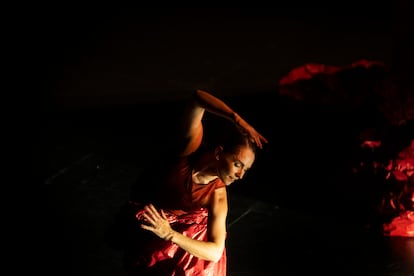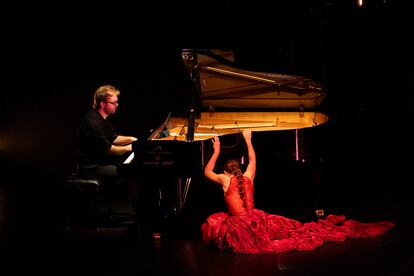There is something reverential in the title of the work, After you, madam (After you, madam), and that is the character that animates and floods the tribute that the dancer Paula Comitre (Seville, 29 years old) pays to the legacy of Antonia Mercé, Argentina (Buenos Aires, 1890-Bayonne, 1936), which she has approached with both respect and devotion, almost a century after his premature death. The work, after its premiere at the Nîmes Festival last February, was presented on Tuesday, for the first time in Spain, at the Teatro Central in Seville, as part of the programme of the XXIII Bienal de Flamenco.
Comitre, a graduate in Flamenco Dance from the Antonio Ruiz Soler Conservatory in Seville, has had an upward career since she joined the Ballet Flamenco de Andalucía under the direction of Rafaela Carrasco just ten years ago in 2013. She shone in her company and in that of David Coria before presenting her first solo work in 2020, Open cameraawarded the Revelation Award at the Jerez Festival and the Giraldillo, in the same category, at the Seville Biennial of the same year. In 2022 she would premiere Allegories (The Limit and its maps) at the Chaillot theatre in Paris and the small-format play Named body.
Con After you, madamin addition to representing a qualitative leap in her career, the dancer has faced the challenge of materializing the story of a spell. Because, although she is aware of the legacy of the legendary dancer and choreographer, she says that her vision of her changed radically after reading her Letters (1915-1936)published by the Documentation Centre for Performing Arts and Music (CDAEM). “Reading her, in her own words, I was able to construct an image of her and let’s say that I was infected by her energy.” Perhaps that same energy was what helped her to write a project about her legacy, which she submitted to a call for applications for a six-month residency at the Academy of Fine Arts in France. She won the scholarship and her stay in Paris provided her with the opportunity for an authentic immersion and investigation into the work of La Argentina.
Paris, the city where Antonia Mercé chose to live to enhance her art and take it to the world. “I feel that I made the most of my time and it was a luxury,” Comitre told EL PAÍS days before the performance in Seville. In the city of light, and with methodical dedication, she researched the countless collections (scores, letters, writings…) that exist about her in the Garnier opera house. “Her archive was a real inspiration,” she said. During those months, she reserved a few hours each day to develop her creative process on La Argentina, with a clear starting point: “Not to assume her dance, something impossible, not wanting to imitate her, but to take her energy.”
“He was an unrivalled talent and, furthermore, since there were very few images of his dance, he didn’t run the risk of contaminating me. In return, and this is the positive side, he forced me to look inside myself,” says the artist. Renowned authors have written about Argentina: Federico García Lorca, André Levinson and Charles Chaplin. “I tried to bring those words to my body, looking for my own contribution, a creation from my eyes, and they really became the source and driving force of that creation,” adds Comitre.
From her eyes, it is the same as saying from a contemporary perspective. A tribute from personal creation, a duality that Comitre insists on: “In the work there is a nod to the artist’s legacy, but with an interpretation and gratitude that are her own.” That same dialectic, which she applies to her dance, extends to elements such as music, scenery or costumes, for which —following the example of the teacher, who brought together all the performing arts in her creations— she wanted to surround herself with people who were not from the guild: “That was my tension for the work.”
An inflatable train robe
In Paris, he met the French pianist Orlando Bass, who “was inspired by the pieces chosen – Falla, Nin or Halfter – to make his own compositions with some references to the original music”. With the same idea, he asked the plastic artist María Alcaide to design an inflatable train that forms part of the scene. For dramaturgical and scenic advice he has relied on La Ejecutora (Fran Pérez Román and Julio León Rocha), with the external vision of David Coria.
Of the six pieces that make up the program, those corresponding to the compositions of the aforementioned authors are called Imaginaries and freely inspire both music and dance. Thus, the Andalusian serenade by Manuel de Falla was the vehicle for a dance expression with contemporary overtones and a dreamlike character. With the Iberian dance Joaquín Nin’s ‘The Queen of Castanets’ would appear, barely hinted at in the first scene. Argentina was a virtuoso of these, which are not materially on stage, but are in the movement of Comitre’s hands and on an adapted piano that reproduces her rhythmic game.

Comitre’s heel-clicking also plays its rhythmic and especially musical role in Nin’s piece, in which her dance grows and extends in an unstoppable succession of forms that go from those feet to a graceful waist, to winged arms and even the expression on her face, perhaps in the way Lorca described the dance of La Argentina. With the Gypsy dance by Ernesto Halfter, who evoked Les Ballets Spagnols (the company from La Argentina), the dance continues to grow and takes on an infinite multiplicity of variations. An unstoppable dancer and a piano that sounds more and more like Spanish music.
Between one piece and another, there is barely a breath: the homage to La Argentina’s time at the Music Hall is also presented in a veiled way, as another imaginary is the dancer’s whistling evoking the ‘Chufla, chufla’ of La Argentina, recorded on one of the many records she recorded. The end comes with the universe of the legendary dancer contained in the train of an immense robe that, inflated, seems to come to life, perhaps a metaphor for what happened with her dances. Wrapped in it and from the floor, Comitre completes her performance singing a clean farruca. Some of Antonia Mercé’s recognised values - delicacy, grace, elegance, plasticity, sense of rhythm or musicality – can be found within a work that is experimental, beautiful, suggestive, and that distills all the affection of a love letter.

